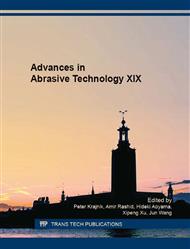p.333
p.339
p.345
p.351
p.357
p.362
p.368
p.375
p.381
Oxide Film Generation during Titanium Alloy Turning in Oxygen-Enriched Atmosphere
Abstract:
The physical and chemical properties of bio-titanium alloy implant surface play an important role on corrosion resistance and biological activity. New turning processes under oxygen-rich atmosphere were presented to obtain required titanium dioxide layer, which can protect implants from corrosion. The thickness of the oxidation film were observed using Auger Electronic Spectrum (AES). Then the corrosion resistance was tested in simulated body fluid by electrochemical corrosion. The results showed that the thickness of oxidation film by turning in oxygen-rich 80% was 69 nm, which was 4.6 times of that under natural conditions (15 nm). The thickness of processing surface oxidation film was increased by turning process under oxygen-rich atmosphere, indicating that this process could slow down the speed of titanium alloy corrosion and significantly improve the corrosion resistance.
Info:
Periodical:
Pages:
357-361
Citation:
Online since:
October 2016
Authors:
Price:
Сopyright:
© 2016 Trans Tech Publications Ltd. All Rights Reserved
Share:
Citation:


